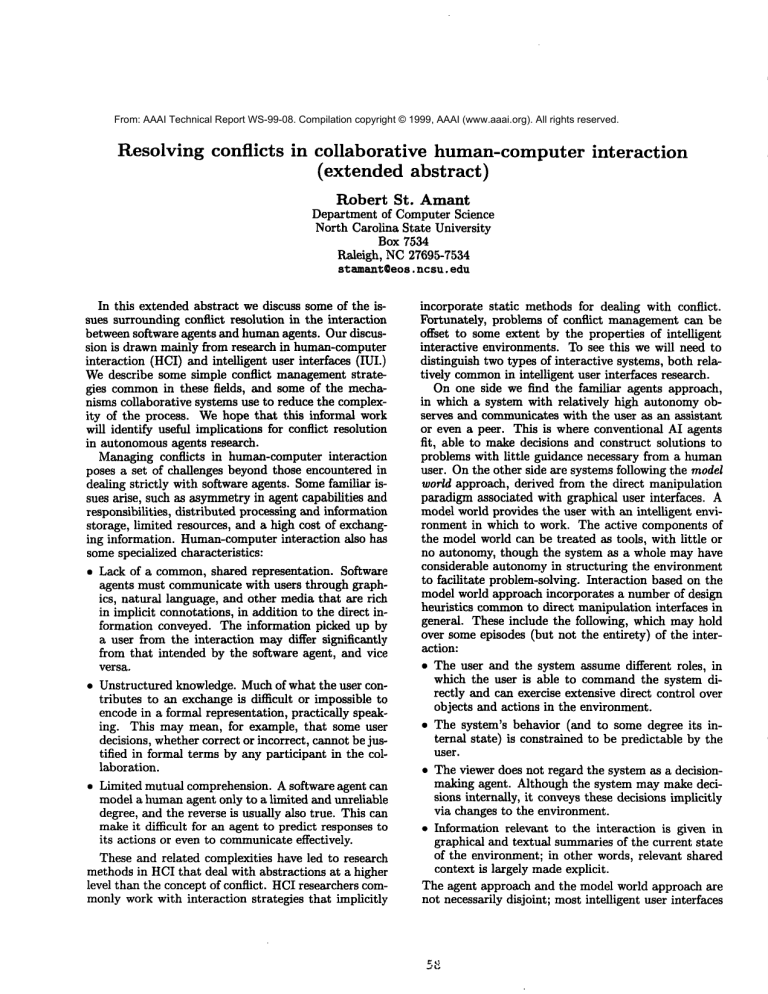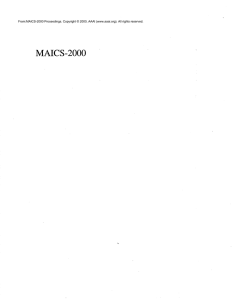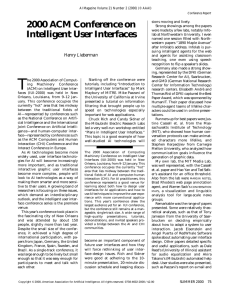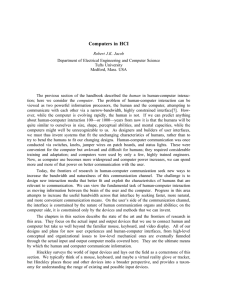
From: AAAI Technical Report WS-99-08. Compilation copyright © 1999, AAAI (www.aaai.org). All rights reserved.
Resolving
conflicts
in collaborative
human-computer interaction
(extended abstract)
Robert
St.
Amant
Department of Computer Science
North Carolina State University
Box 7534
Raleigh, NC27695-7534
st amanl;@eos,
ncsu.edu
In this extended abstract we discuss some of the issues surrounding conflict resolution in the interaction
between software agents and humanagents. Our discussion is drawn mainly from research in human-computer
interaction (HCI) and intelligent user interfaces (IUI.)
Wedescribe some simple conflict management strategies commonin these fields, and some of the mechanisms collaborative systems use to reduce the complexity of the process. Wehope that this informal work
will identify useful implications for conflict resolution
in autonomous agents research.
Managing conflicts in human-computer interaction
poses a set of challenges beyond those encountered in
dealing strictly with software agents. Somefamiliar issues arise, such as asymmetryin agent capabilities and
responsibilities, distributed processing and information
storage, limited resources, and a high cost of exchanging information. Human-computerinteraction also has
somespecialized characteristics:
¯ Lack of a common, shared representation.
Software
agents must communicate with users through graphics, natural language, and other media that are rich
in implicit connotations, in addition to the direct information conveyed. The information picked up by
a user from the interaction maydiffer significantly
from that intended by the software agent, and vice
versa.
¯ Unstructured knowledge. Muchof what the user contributes to an exchange is difficult or impossible to
encode in a formal representation, practically speaking. This may mean, for example, that some user
decisions, whether correct or incorrect, cannot be justified in formal terms by any participant in the collaboration.
¯ Limited mutual comprehension. A software agent can
model a humanagent only to a limited and unreliable
degree, and the reverse is usually also true. This can
makeit difficult for an agent to predict responses to
its actions or even to communicateeffectively.
These and related complexities have led to research
methods in HCIthat deal with abstractions at a higher
level than the concept of conflict. HCIresearchers commonly work with interaction strategies that implicitly
incorporate static methods for dealing with conflict.
Fortunately, problems of conflict management can be
offset to some extent by the properties of intelligent
interactive environments. To see this we will need to
distinguish two types of interactive systems, both relatively common
in intelligent user interfaces research.
On one side we find the familiar agents approach,
in which a system with relatively high autonomy observes and communicateswith the user as an assistant
or even a peer. This is where conventional AI agents
fit, able to make decisions and construct solutions to
problems with little guidance necessary from a human
user. On the other side are systems following the model
world approach, derived from the direct manipulation
paradigm associated with graphical user interfaces. A
model world provides the user with an intelligent environment in which to work. The active components of
the model world can be treated as tools, with little or
no autonomy, though the system as a whole may have
considerable autonomy in structuring the environment
to facilitate problem-solving. Interaction based on the
model world approach incorporates a number of design
heuristics commonto direct manipulation interfaces in
general. These include the following, which may hold
over some episodes (but not the entirety) of the interaction:
¯ The user and the system assume different roles, in
which the user is able to commandthe system directly and can exercise extensive direct control over
objects and actions in the environment.
¯ The system’s behavior (and to some degree its internal state) is constrained to be predictable by the
user.
¯ The viewer does not regard the system as a decisionmaking agent. Although the system may make decisions internally, it conveysthese decisions implicitly
via changes to the environment.
¯ Information relevant to the interaction is given in
graphical and textual summaries of the current state
of the environment; in other words, relevant shared
context is largely madeexplicit.
The agent approach and the model world approach are
not necessarily disjoint; most intelligent user interfaces
have characteristics of both.
The benefit of adopting the model world approach in
a collaborative system is that the system can manage
the problem-solving environment so as to constrain and
simplify conflict detection and resolution.
Let’s take as an example the appointment scheduling
problem. (Multi-user/multi-agent interfaces are beyond
the scope of this abstract.) By imposing structure on
its interaction with a user, an agent that relies on a
model world can heuristically simplify or avoid manyof
the problems of conflict identification and resolution.
These simplifications are not without cost; it is very
commonfor the system simply to abdicate responsibility to the user on detecting any sort of problem. Consider, for example, a "wizard" interface for making appointments. At each step the user is given relevant
information about a potential conflict, such as overbooking a single time slot. If a problem arises the user
is free to cancel the procedure, but the system takes
no action on its own to repair the problem. This is a
trivial one-shot exampleof conflict resolution.
Other, slightly more sophisticated strategies are possible, however, that remain within the strictest limitations of the model world approach. Wecan treat the
agent interacting with user (or rather, the agent acting
through the model world environment) as interactive
search through a space of decisions, where some are
made by the user and some by the system, possibly
without the user’s direct observation. The system can
apply various mechanisms to reduce the probability of
conflicts occurring.
Structure the interaction such that the probability of
conflicts arising is minimized. In the wizard interface
suggested above, the system might suggest time slots
for a desired appointment, waiting on the user’s approval. The suggestions might be selected using some
best-fit heuristic to delay the occurrenceof conflicts.
Structure the interaction such that the cost of dealing with potential conflicts is minimized. The goal is
similar to the delaying tactic above, but here actions
might be taken that reduce overall cost.
The system can also reduce the cost of resolving conflicts whenthey arise.
On detection of conflict, present justification ]or a
given action or belief. This is commonlyseen in decision support and expert systems, which may present
a trace of rule firings or a network of relations. The
system may or may not have be flexible in its response, deferring to the user or simply continuing
without change. While simplistic, this strategy is often sufficient to resolve conflict by forcing the user to
change his or her belief.
On detection of conflict, present relevant environment
information. This is a comparable but distinct strategy from the above, in which the system lays out
relevant features of the problem (rather than its solution in more detail.) Again, while simplistic, this
often serves to resolve conflict.
Structure the interaction such that the user is presented with a restricted set of actions, eliminating
those likely to lead to a conflict.
Structure the interaction such that the perceived cost
of taking an action is reducedif it is less likely to lead
to a conflict.
These are not simply abstractions tailored to the concept of conflict; we see such mechanisms in existing
systems aimed directly at facilitating collaboration between the user and the system. In our presentation
these basics and related issues will be expanded and
discussed in more detail.








